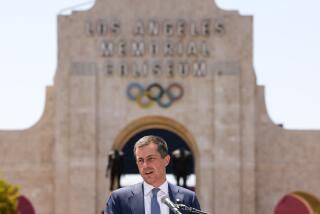Mass Transit Group Lobbies for Bigger Funding Share
- Share via
WASHINGTON — Jack Gilstrap winced as President Bush introduced Transportation Secretary Samuel K. Skinner as “my road warrior.”
The word road , according to Gilstrap, is the key problem with the Bush Administration’s approach to transportation.
“The point is that the transit people don’t have the voice in Washington that the highway people do,” said Gilstrap, executive vice president of the American Public Transport Assn., which represents more than 95% of the nation’s transit systems.
“The average transit user is a working stiff who doesn’t have a lot of lobbyists in Washington working on his behalf. There are times when we are just a bit outgunned.”
Gilstrap and his colleagues are trying to garner a larger share of the $105 billion Bush wants spent on surface transportation. The five-year bill earmarks $87.17 billion for highways and $16.3 billion for mass transit.
Last week, a Senate committee approved a bill that would do that. The Senate Committee on Environment and Public Works voted, 15 to 1, to approve the Surface Transportation Efficiency Act of 1991, written chiefly by Sen. Daniel Patrick Moynihan (D-N.Y.). It would grant states unprecedented authority to decide whether to spend billions of dollars in federal assistance on highways or on mass transit systems.
Gilstrap’s arguments:
* More commuters taking trains means less traffic congestion.
* Burning less gasoline will curb air pollution and reliance on foreign oil.
But the Administration sees highway congestion as the central problem, Skinner said in an interview. Less congestion translates into fuel conservation and reduced air pollution, he said.
Skinner said congestion “is not only limited to areas where mass transit is around, but to many other areas where it is not.”
That, he said, casts doubt on mass transit’s potential.
“If we doubled the number of mass transit riders we would only decrease congestion by 2%,” Skinner said.
Gilstrap sees an anti-city bias in Skinner’s approach.
“There has been for the last 10 years a basic belief that cities were someone else’s responsibility, and the welfare of cities was of no concern--or of little concern--to the Administration,” he said.
“That’s a very poor understanding of the needs of the nation,” he said, because “75% of the people live in the largest cities, and air quality is one of the greatest problems we have.”
The Bush bill would give states new flexibility in transferring highway funds to mass transit, but eliminate federal transit operating subsidies--a step transit officials say will mean rising fares and loss of riders.
Brian Clymer, head of the Urban Mass Transit Administration, said it is time to end subsidies and focus on capital investment.
“Legally, we don’t have any authority over how that operating money is spent,” Clymer said. “We are not able to run these local transit operations.”
Skinner said last year’s budget deficit reduction act puts a tight cap on what can be done.
“The money is not there to do everything for everybody,” he said. “Highway users feel that not enough money is being spent on the highways.”
Kenneth M. Mead, director of transportation issues for the congressional General Accounting Office, said federal mass transit funds have fallen, from $4.6 billion in 1981 to $3.2 billion this year.
Mead and others see a basic conflict between mass transit and highways.
“Transit’s objective is to move people out of their cars, while a highway goal is to build roads that can accommodate more and more cars,” he told Congress recently.
Clymer counts 16 billion to 17 billion rider miles a year on mass transit, against 3 trillion automobile miles driven yearly.
“We try to build a budget based on needs,” said Clymer, a former member of the board of directors of the Philadelphia transit system. “I think we have some disagreement about where the true needs are.”
Gilstrap said: “Some of our systems, such as Philadelphia’s, are facing a very critical financial situation. Others have chronic problems.”
He said that mass transit needs $90 billion over the next six years to rehabilitate or buy vehicles and maintain systems, but only $21 billion is available.
But he sees change ahead.
“We are just now coming to the twilight of an era where we thought we could have a transportation system dependent on the private automobile,” Gilstrap said.
“And I think we can predict a major shift in policy that will see a balanced transportation policy being implemented in this country.”
More to Read
Sign up for Essential California
The most important California stories and recommendations in your inbox every morning.
You may occasionally receive promotional content from the Los Angeles Times.










